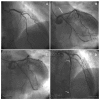Coronary vasomotion dysfunction after everolimus-eluting stent implantation
- PMID: 25598992
- PMCID: PMC4274358
- DOI: 10.1556/IMAS.6.2014.4.6
Coronary vasomotion dysfunction after everolimus-eluting stent implantation
Abstract
First generation drug-eluting stent can cause a paradoxical "in-segment" coronary vasoconstriction. This phenomenon was seen with sirolimus, paclitaxel, and, more recently, also with zotarolimus-eluting stent. For the first time, we describe a case of coronary-induced vasoconstriction by everolimus-eluting stents (EES).
Keywords: DES; coronary artery disease; coronary flow reserve; coronary spasm; everolimus-eluting stent.
Conflict of interest statement
Figures






References
-
- Hamilos M, Sarma J, Ostojic M, Cuisset T, Sarno G, Melikian N, Ntalianis A, Muller O, Barbato E, Beleslin B, Sagic D, De Bruyne B, Bartunek J, Wijns W. Interference of drug-eluting stents with endothelium-dependent coronary vasomotion: evidence for device-specific responses. Circ Cardiovasc Interv. 2008 Dec;1(3):193–200. - PubMed
-
- Barbato E, Piscione F, Bartunek J, Galasso G, Cirillo P, De Luca G, Iaccarino G, De Bruyne B, Chiariello M, Wijns W. Role of beta2 adrenergic receptors in human atherosclerotic coronary arteries. Circulation. 2005 Jan 25;111(3):288–294. - PubMed
-
- Togni M, Windecker S, Cocchia R, Wenaweser P, Cook S, Billinger M, Meier B, Hess OM. Sirolimus-eluting stents associated with paradoxic coronary vasoconstriction. J Am Coll Cardiol. 2005 Jul 19;46(2):231–236. - PubMed
Publication types
LinkOut - more resources
Full Text Sources
Other Literature Sources
